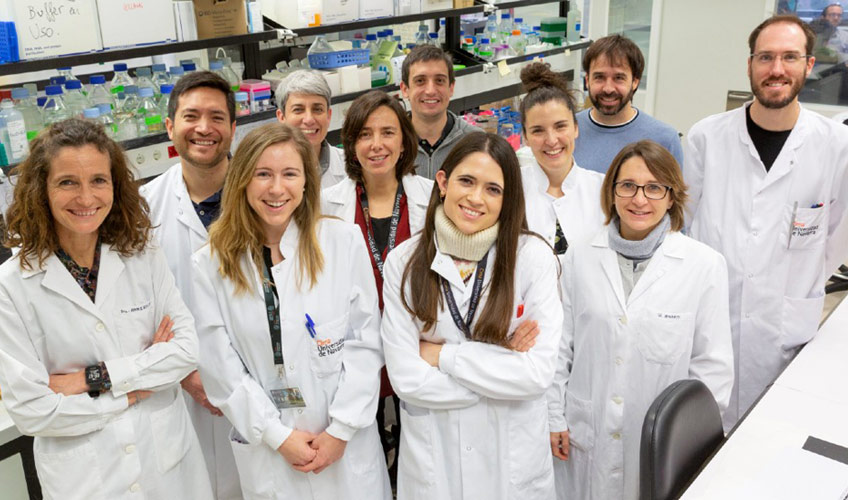Inflammation in Parkinson's disease varies by brain region
Researchers at Cima University of Navarra discover in animal models that the immune response is different depending on the brain region affected by the degenerative process of this disease.

FotoManuel Castells<br>/De izquierda a derecha: Marisol Aymerich, Rodrigo Vinueza, Leyre Basurco, Elisa Mengual, Montse Arrasate, Mikel Hernáez, Leyre Ayerra, Amaya Vilas, Ibon Tamayo, Esther Luquin y Patxi San Martin.
12 | 01 | 2023
Researchers at Cima University of Navarra have identified for the first time specific mechanisms of the immune system response during the degenerative process that takes place in Parkinson's disease. Using advanced sequencing and flow cytometry techniques, they have discovered in animal models that the inflammatory reaction varies depending on the brain regions affected by neuronal death and is different from that described in other neurodegenerative diseases. This finding opens the door to design of neuroprotective strategies aimed at specifically modulating this inflammatory response during the active phase of neuronal death.
The results of this study have been published in GLIA, a scientific journal focused on the research of the structure and function of the set of nerve cells that accompany neurons in the nervous system, called glia. In turn, Nature Reviews Neurology, the second most relevant scientific journal on Clinical Neurology, has highlighted the importance of these findings as the main research of a series of specialized and general medical journals.
Parkinson's disease and the immune system
Parkinson's disease is a neurodegenerative disease caused by the progressive death of dopamine-producing neurons. The decrease of dopamine levels in the brain below a specific threshold causes the movement difficulties characteristic of the disease and some other secondary symptoms. One of the causes contributing to the loss of dopaminergic neurons is the accumulation of the protein alpha-synuclein within these neurons. "Alpha-synuclein is a protein core topic implicated in Parkinson's disease that may trigger a specific inflammatory response that accelerates neuronal death," says Dr. Marisol Aymerich, a researcher at Cima and lead author of the study.
Inflammatory differences according to brain region
The death of neurons produces changes in the surrounding glia cells. These cells are of various types, smaller and more numerous than neurons. They have different functions such as giving structural and metabolic support to the neurons (the astrocytes) or being alert to eliminate any subject cellular waste or detect infections that may reach the brain (the microglia), constituting the brain's immune system. When the damaged neurons begin to degenerate, these functions are lost and an inflammatory response is triggered which, at first, tries to resolve the damage, but when it becomes chronic it contributes to neuronal death.
"In this work we have focused on the study of two brain regions, the striatum and the substantia nigra. We have shown that when alpha-synuclein protein induces the death of dopaminergic neurons, in the substantia nigra, the reaction of microglia is anti-inflammatory. However, in the striatum (region where dopamine is released), it is pro-inflammatory. This shows that glia cells change their inflammation-mediating function depending on the brain region," explains Leyre Basurco, also a researcher at Cima and first author of the study.
This work delves into the role of the immune response in neuronal death and its findings could have important implications for efforts aimed at modulating the inflammatory response for the treatment of Parkinson's disease. "These results highlight the need to correctly identify therapeutic targets to develop neuroprotection treatments based on immune modulation since at the same time different brain regions may have different responses. A question core topic for the project of research will be to determine which stage of the inflammatory reaction that takes place in Parkinson's disease is being reproduced by the experimental models," concludes Aymerich.
This work has been financed by the Ministry of Science, Innovation and Universities through FEDER funds, the Government of Navarra, the Gangoiti Foundation, among others.
reference letter bibliography:
→ Basurco, Leyre et al. "Microglia and astrocyte activation is region-dependent in the α-synuclein mouse model of Parkinson's disease." Glia. 10 Nov. 2022, DOI:10.1002/glia.24295.

